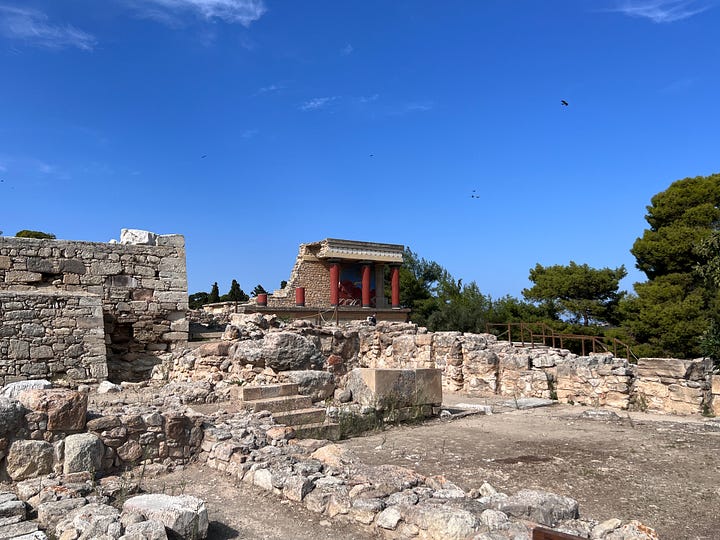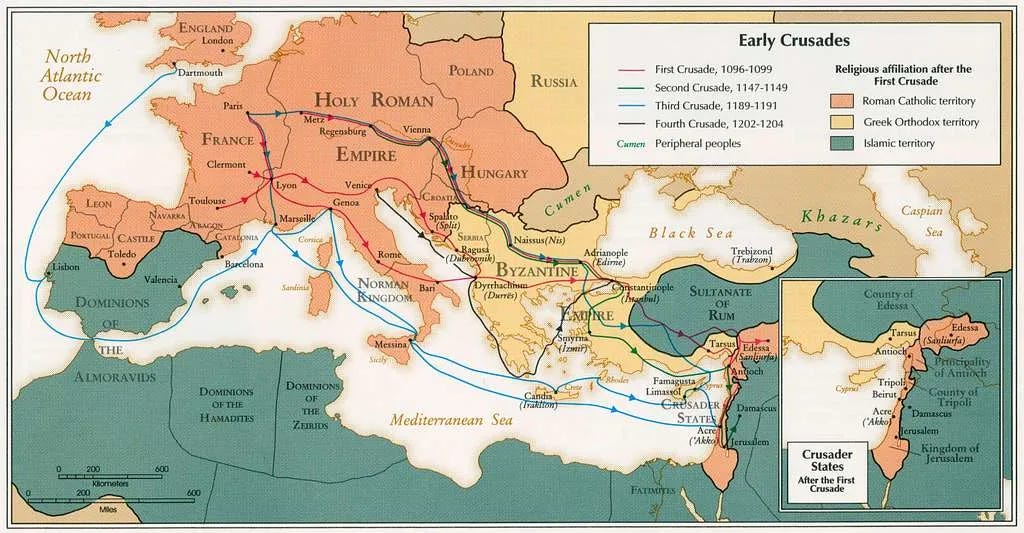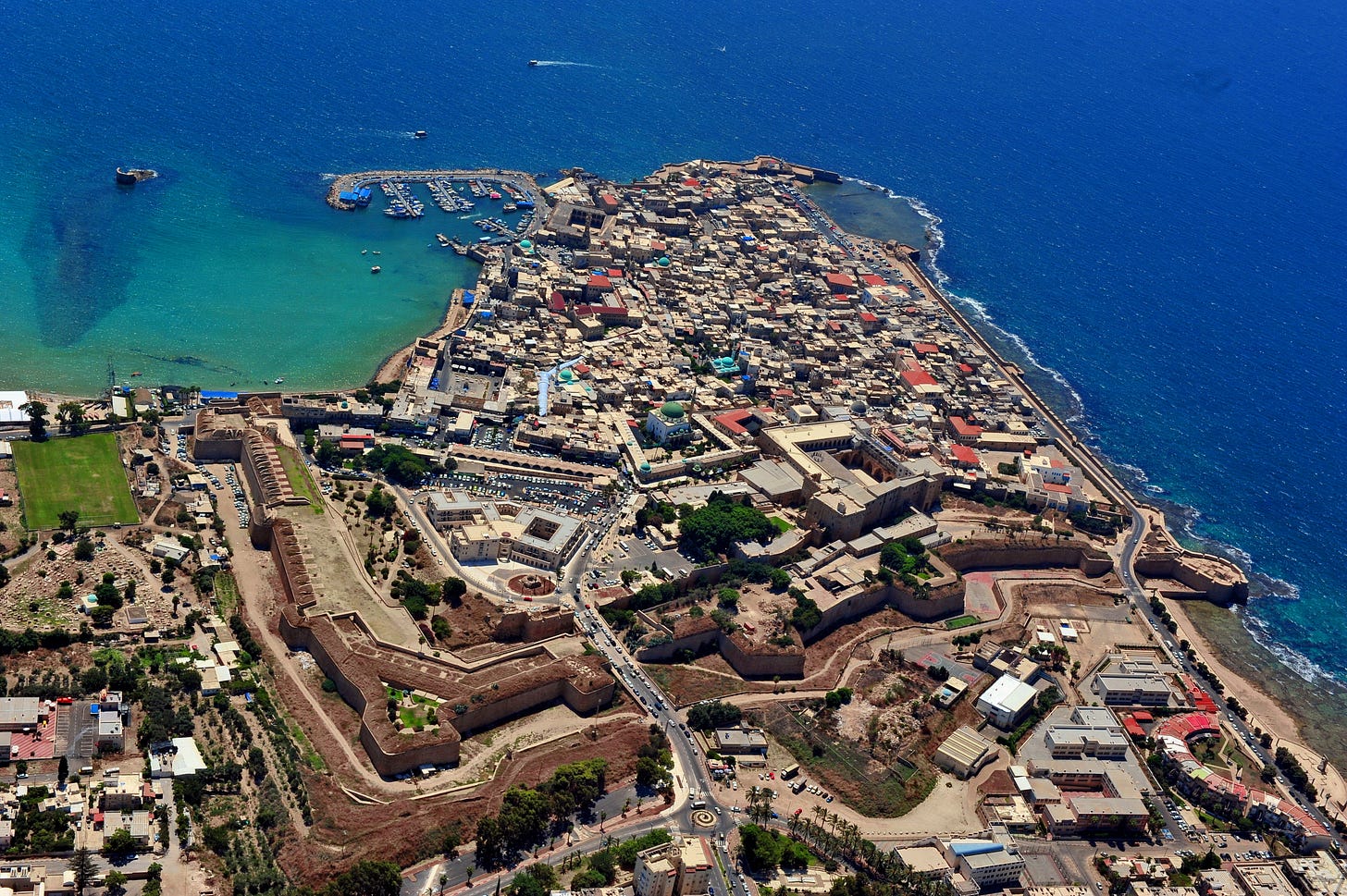Sailing the Mediterranean with Richard
I will sing to keep my courage up
since I must comfort my heart
for in my great distress
I not to wish to die or go mad
when from the savage land
I see anybody return,
where he has gone who soothes
my heart when I hear him mentioned.
God, when they shout "Overseas!,"
O Lord, help the pilgrim
for whose sake I tremble
for treacherous are the Saracens.1
(It probably goes without saying I don’t endorse that last characterization; the song is an historical artifact, with a beautiful melody).
Richard the Lionheart was the first crusader to sail from Europe to the Holy Land. Previous crusades went overland, through Constantinople/Byzantium/Istanbul typically. The Second Crusade had some amount of sailing by some groups in the shores near to Palestine, but by and large people went by land. Richard’s mother Eleanor of Aquitaine went on the Second Crusade with her first husband King Louis of France. Weather, terrain, and hostile governments fearful of a large crusader army on their doorstep made this method slow and dangerous. I can find no direct evidence of it, but one easily speculates that Richard learned from his mother’s experience and decided to sail.
Richard set out in December of 1189, shortly after being crowned King. He went through France, as he needed to meet with King Philip of France, who would accompany him on crusade. He would eventually reach Marseille and begin his sail in early August of 1190, headed for Messina, Sicily. Meanwhile, his main fleet had assembled in England, and sailed down past France and Portugal, headed for the Straight of Gibraltar.
The sail was mostly uneventful, except for a large storm, which the fleet survived. Worse, when the crusaders went ashore in Lisbon, a sailor-led drunken riot ensued. Robert de Sablé, the fleet commander (and eventual Grand Master of the Knights Templar), had to bail out hundreds of sailors from jail. He eventually settled matters with the King of Portugal and was on his way. They hugged the coast through the Straight of Gibraltar, hitting various ports on their way to Marseille. As we discussed in Traveling at Sea in the Middle Ages, navigation at that time was mostly coastal navigation, from city to city, ideally stopping overnight to avoid sailing in the dark.
Eventually the main fleet made it to Marseille, their rendezvous point with Richard, only to find him recently departed. They rapidly followed him to Sicily, meeting in Messina in late September 1190. I was fortunate to visit Messina last year; that visit sparked my initial interest in Richard.


Sicily is home to a number of myths, many of them relevant for sea-farers. Scylla and Charybdis guarded the Straight of Messina; Charybdis the whirlpool on the far side, Scylla the twelve footed monster with six heads, full of teeth, on long, snaky necks. Following Circe’s advice, Odysseus sailed closer to Scylla, for to lose six sailors (as he did) was better than losing the entire ship. To this day, “between Scylla and Charybdis” means to be caught between two bad options.
Sicily was also the home of the Fata Morgana (“Fairy Morgana”), a form of nautical mirage producing an appearance of castles in the sky over the ocean. Morgana, from Arthurian lore, reputedly lived in Sicily. Sicily was also (at least in Sicilian legend) the home of Dionysus, the Greek God of revelry and drunken religious orgies.
By the time the crusaders left Sicily in the spring (nobody sailed the Mediterranean during the winter for fear of storms), the fleet had swelled to about two hundred ships and roughly an estimated 10,000-15,000 men. There was one large dromond, carrying hundreds of men, Richard’s fiancé Berengaria and his sister Queen Joanna of Sicily. Two large treasure ships carried much of Richard’s treasure - the rest was spread amongst the remaining ships for safety. Then came the busses, small to medium size cargo ships. In Richard’s case the busses often carried knights and horses. The horses were kept in slings and on their feet. Last came the snekkars, small and fast war galleys that shared a design with Viking longships (more details and pictures here). Here is the (sometimes snarky) contemporary historian Richard of Devizes:
The fleet of Richard, king of the English, put out to sea, and proceeded in this order. In the forefront went three ships only, in one of which was the queen of Sicily and the young damsel of Navarre, probably still a virgin; in the other two, a certain part of the king’s treasure and arms; in each of the three, marines and provisions. In the second line there were, what with ships and busses and men of war, thirteen; in the third, fourteen; in the fourth, twenty; in the fifth, thirty; in the sixth, forty; in the seventh, sixty; in the last, the king himself followed with his galleys. There was between the ships, and between their lines, a certain space left by the sailors at such interval, that from one line to another the sound of the trumpet from one ship to another, the human voice, could be heard. This also was admirable, that the king was no less cheerful and healthy, strong and mighty, light and gay, at sea, than he was wont to be by land. I conclude, therefore, that there was not one man more powerful than he in the world, either by land or sea.
The fleet was shortly be becalmed for about three days; then a violent storm rose up late in the day, and continued into the night. Imagine your task is to sail through this, with your cobbled together medieval wooden 40’ war galley, powered by oars and a small sail, with only the sun and stars to guide you, IN THE DARK!

When the light rose in the morning, a number of ships were missing including twenty five galleys, and worse, the Great Ship with Berengaria on board. (Lest you think it is all storms in the Mediterranean, here’s a few shots of our cruise, which was in November, the time it supposed to be dangerous to sail.)


At the time, Richard did not know whether the ship was sunk, or simply lost. He proceeded with the main fleet to Heraklion, Crete, arriving in late April, where they took on water and remained a few days in hopes the other ships would appear.
Crete, as you may know, was the historical home of the Minoan sea-faring culture that ruled the Mediterranean from around 3500 BC to 1100 BC. It was also the legendary birthplace of Zeus, and the home of the mythical (?!) Minotaur. The fleet would see little of Crete, sailing within a few days, but I was fortunate enough to go to Crete and visit the Palace of Knossos and the reputed home of the Minotaur and the Labyrinth.


Richard then sailed for Rhodes, the next rendezvous point he had identified, arriving about a week later. In antiquity Rhodes was a major naval power, even though it is “just” a city on a small island. To the Crusaders, it was an enormous city from antiquity, nearing Rome in its fame and scale. From the The History of the Holy War, by Ambroise, who traveled with King Richard, and as translated by Marianne Ailes:
Rhodes was a great city, of ancient antiquity almost as great as Rome. One could scarcely appreciate the whole of it, for there were so many houses that had been destroyed, ruined walls and towers, and so many great churches that still stand because of the number of people who have been there through the years and across the ages and under so many different lordships, that no man could count them without difficulty. Nor could anyone estimate its greatness and nobility, now fallen through age. However, there lived there people who sold us food.
Rhodes is perhaps best known now for The Colossus of Rhodes, a 100 foot tall bronze statute dedicated to the sun god Helios. Rhodes is named for the sea nymph Rhode, the daughter of Poseidon and the wife of Helios. The Colossus was destroyed in an earthquake, and not reconstructed for fear of a prophecy from the Oracle of Delphi. It was one of the Seven Wonders of the Ancient World along with the pyramids of Giza and others. But I digress.
Rhodes would eventually be controlled by the Knights of Saint John — the Hospitallers, an organization not unlike the Knights Templar, and the Hospitallers would play a key role in Richard’s crusader forces.



Richard became ill, and the fleet remained in Rhodes for about ten days, during which time the news came that the lost ships were stuck at Cyprus - some wrecked, some being held. Berengaria and the treasure were safe, for the moment. Off sailed the fleet to Cyprus.
Cyprus also has a long and storied history. It is the legendary home of Aphrodite, the god of love, and its location made it a prize in all eras, sitting as it does as a gateway between the rest of the Mediterranean and the Middle East. This fact did not escape Richard’s attention, and after arriving from Rhodes, he quickly became embroiled in a conflict with the Emperor of Cyprus, Isaac Comnenus, a not-very-nice guy. Historical opinions vary as to whether Richard went to Cyprus with a plan to conquer it, or whether that was simply a natural outgrowth of events, but in any case within two weeks he had conquered the island. As a condition of surrender, Isaac insisted he not be put in “fetters of iron”, or chains. Richard happily agreed, then had chains of silver made, and held Isaac in those. Can’t say the man didn’t have a sense of humor.
While Richard was there, he took the opportunity to finally marry his fiancé Berengaria; he had been unable to marry her in Messina because it was Lent during her time there. While Richard was there, Guy de Lusignan, the nominal King of Jerusalem came to visit him. Yes, the Guy who tried to take Richard’s mother Eleanor hostage back in the day, in France. Strangely, Richard welcomed him with open arms.

Guy had recently been released from a year in the captivity of Saladin, after the disastrous Battle of Hattin. In the meantime, King Philip of France, once Richard’s friend, now his rival—Richard and Philip might be the original “frenemies”—is maneuvering to put Conrad of Montferrat in as King of Jerusalem. Guy wants Richard’s help, and “enemy of my enemy is my friend” and all that, Richard agrees. Keeping in mind, Jerusalem is under the control of Saladin, so this is all a bit theoretical, but nonetheless. (If you’ve watched Kingdom of Heaven, Guy and the Battle of Hattin will seem familiar to you. If you haven’t, do! :)).
Finally, Richard is ready. On June 5th, 1191, Richard sails from Cyprus, making landfall at Marqab Castle, then Tyre, but sails on until he reaches Acre. He will join the crusader forces besieging Acre. A year and a half after leaving England, he is finally ready to enter battle.
If Acre interests you, let me recommend a show: Lost Cities by Albert Lin. In this episode, he searches for the lost treasure of the Knights Templar beneath Acre. Good fun.
https://oltramar.livejournal.com/43677.html









